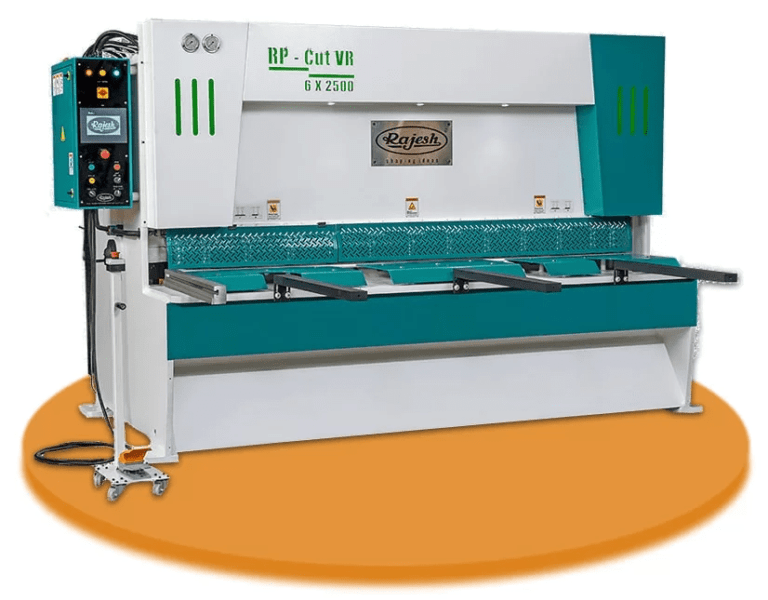
Shearing is the process of cutting sheet metal, bars, and plates by applying shear stress using a die and a punch, which is very similar to punching paper. The die and punch can have different shapes, such as circular or straight blades that resemble scissors. Shearing machines include punching machines for small discs, blanking machines for washer production, etc. Usually, shearing operations are used to split metals into sheets or strips. The type of blade used for shearing—a straight or rotatory edge determines the process of shearing a plate, sheet, or strip.
Classification of Shearing Machines:
Shearing machines and other related machinery are used in the first phase of metal sheet manufacturing, which involves cutting the sheet metal to size. These machines are versatile tools for cutting sheet metal and other alloys. A few shearing machines work similarly to scissor blades, cutting metal into strips or sheets using angular shear action. Straight shear action, in which the edges are fixed at an angle opposite to the angular movement, is used in specific large machines.
Shearing is usually performed with the help of two blades, one fixed to the shear bed and the other moved vertically with little to no clearance. The shearing handle proceeds gradually from one side of the material to the other. The term “rake” refers to the angular configuration in blades. The thickness and kind of material to be cut entirely determines clearance and rake.
If the shears are press type, the inclination between the upper and lower blades is between 0.5 and 2.5 degrees.
One of the blades is usually mounted on a fixed bed in shearing machines, and the workpiece is held in place while cutting by a set of hold-down pins and a vertically advancing crosshead.
Shearing Machines Diagram

Working of Shearing Machines:
The most popular shearing machine operation, punching, is used to scrap sheared slug. Shearing also takes place between a punch and a die. Punching, Cutting, blanking, Piercing, notching, Perforating, and nibbling are all part of the shearing operation.
1. Punching or Blanking:
Using a punch to remove material from a strip of sheet metal or a more significant piece is known as blanking or punching. Punching means removing small pieces; blanking means removing small scrap parts and the remaining helpful portion.
2. Cutting:
Very little excess metal is spread on the parting plane during drop forging or die-casting parts production. The extra metal, referred to as flash, is removed from the part during the trimming process before it is used. Blanking and trimming are similar processes, and the dies used in each process are similar.
3. Piercing
Piercing is the definition of tearing a hole in metal. Because slug is not generated during piercing, it differs from punching. A drilled hole resembles a bullet hole in a metal sheet rather closely.
4. Nibbling
Nibbling is a particular notching where the metal is sliced with overlapping notches. Nibbling is used to create any desired shape, such as flanges or collars.
5. Perforating
The process of creating a uniform spacing of holes in a metal sheet that can be any size or shape and cover the entire sheet is known as this.
6. Making a notch
Cutting a small amount of metal from a blank is known as notching. Because the cutting line of the slug touches one edge of the strip or blank during notching, it differs from punching. Any shape can be used for notches.
Types of Shearing Machines:
Rajesh Machines has been a sheet metal manufacturer since 1984, specializing in offering a comprehensive range of machine tools. Explore our machinery, including Shearing Machines, Hydraulic shearing machines, CNC shearing machines, and more. We offer competitive hydraulic shearing machine prices to meet your manufacturing needs.
1. NC Swing Beam Shearing Machine:
An NC (Numerically Controlled) swing beam shearing machine is a precision cutting instrument used in metal fabrication processes. Unlike conventional manual or mechanical shearing machines, an NC Swing Beam Shearing Machine uses computerized numerical control, which automates and improves cutting accuracy.
The moving motion of the upper blade, which swings to carry out the cutting action, is called the “swing beam” design. Among the numerous advantages of this design are improved blade alignment and less material distortion during cutting. The workpiece is subjected to less force and a smoother cut because of the swinging motion.
2. Hydraulic Guillotine Shearing Machine:
Sheet metal can be cut straight with a mechanical tool called a hydraulic guillotine shearing machine. It uses hydraulic power to turn a fixed lower blade into a scissor-like action that shears the metal between it and the moving upper blade. The word “guillotine” describes the upper blade’s vertical motion as it descends to precisely and cleanly cut the material.
3. Mechanical Under Crank Shearing:
Sheet metal can be sheared or cut into the required shapes or sizes using a mechanical power-driven machine called a mechanical under crank shearing machine. The phrase “under crank” describes the machine’s driving mechanism positioned below the device’s frame.
Rajesh Machines has been a sheet metal manufacturer since 1984, specializing in offering a comprehensive range of machine tools. Explore our machinery, including Shearing Machines, Hydraulic shearing machines, CNC shearing machines, and more. We offer competitive hydraulic shearing machine prices to meet your manufacturing needs.
